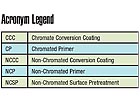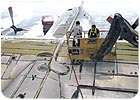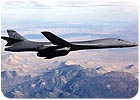Eliminating Hexavalent Chrome
A new generation of non-chromated primer combined with a non-chromated surface pretreatment is paving the way for the aerospace and other industries to begin shifting to total non-chromated systems.

A major pollution prevention goal for the aerospace industry is to reduce and eventually eliminate the use of chromates. Hexavalent chrome, a classified human carcinogen, has been tied to lung cancer for about 50 years. In the aerospace industry, the principal exposure to hexavalent chrome occurs during application of chromated primers and coatings and mechanical sanding of the painted surfaces. This toxic substance enters the body by inhalation, ingestion or absorption through the skin. Most recently the Occupational Safety and Health Administration (OSHA) issued a ruling that dramatically limits the permissible exposure to hexavalent chrome. The rule, effective May 30, 2006, establishes an eight-hour time-weighted average exposure limit of 25 micrograms of hexavalent chrome per cubic meter of air (25 μg/m3) for the aerospace industry - a 52 percent reduction to the previous standard.
Under the same OSHA ruling, other industries are required to lower the permissible exposure limit (PEL) to 5 μg/m3, a 90 percent reduction. The aerospace industry was granted a lower reduction due to the lack of available non-chrome paint systems. However, as legislation limiting hexavalent chrome continues to roll out, all businesses are searching for nontoxic, chromium-free solutions to a problem that is now affecting their bottom line.

Replacements can be divided into two categories: non-chromated conversion coatings (NCCCs) and non-chromated surface pretreatments (NCSPs) that do not convert the substrate. Initially, both of these non-chromated replacements for the chromate conversion coating looked promising because they reduced the chrome waste by two-thirds, as opposed to only a one-third reduction when replacing the chromated primers.


Another attempt was to combine NCSPs and early-generation NCPs. However, since NCSPs do not convert the substrate and are not designed to work with the older generations of non-chromated primers, there were no successes. The NCSP relies on superior adhesion and flexibility, as well as the corrosion inhibiting properties of the paint system, to successfully protect the substrate.
A new generation of NCP was developed that provides equal corrosion protection to the original chromated primers. This new primer was introduced and tested with both the NCCCs and the NCSPs. Although the chrome waste was eliminated in both, the success of the new NCP/NCCC combination was minimized due to the inherent limitations of the NCCC system (i.e., restricted to specific substrates, generates hazardous waste, still regulated, etc.).
Conversely, the combination of the new NCP and the NCSP is proving to be a viable total non-chrome solution for the industry. This system, called PreKote® Surface Pretreatment, combines the corrosion efficiency of the new generation of NCP with the flexibility, adaptability and safety of NCSPs. Extensive laboratory and recent field testing has been showing that this complete non-chrome solution provides ample corrosion protection and superior paint adhesion. In addition, it is not regulated under 40 CFR 433, can be used on most substrates and does not contain any chrome waste or generate additional hazardous waste. The success with PreKote Surface Pretreatment as a NCSP, as well as others, is paving the way for the industry to begin shifting to total non-chromated systems.

The first F-16 was painted in 1997, and the test was complete in 1998 showing excellent results. In 2000 the Technical Order (TO) for repainting F-16s was changed to include specifications to use PreKote as a NCSP. With more testing completed in June 2004, TO 1-1-8 was also changed, authorizing the use of the reformulated NCSP product on any USAF plane. Today, the reformulated NCSP product is flying on multiple platforms with continued success.
The PreKote Surface Pretreatment technology has contributed to the U.S. Air Force (USAF) eliminating numerous hazardous products, as well as saving on disposal costs. With the PreKote, finishers required less time to prepare, monitor and paint the aircraft, reducing personal protective equipment and other chromium related requirements. The NCSP is not EPA regulated under 40 CFR 433 and can be used on substrates including aluminum, magnesium, cadmium, steel, composite materials, anodized and non-anodized metals.
It is important to recognize that PreKote Surface Pretreatment is not a conversion coating, does not permanently change the surface of the substrate, and is designed to be an integral part of the coating system, and therefore was not designed to pass a 168-hour salt spray corrosion test. As stated previously, PreKote Surface Pretreatment is not designed to be used as a stand-alone product but in conjunction with a coating. The PreKote treated panels that have been painted perform as well as or better than panels that have been prepared with CCC and painted, including a 3000-hour salt spray test. The pretreatment has been identified by the U.S. Environmental Protection Agency (EPA) as a pollution prevention technology; the agency's report concluded that PreKote Surface Pretreatment reduces worker exposure to solvents and other toxic chemicals traditionally used in the painting operation.3
Based on all of the accumulated success with the PreKote technology, the USAF contacted the EPA Water Division for clarification on the Metal Finishing effluent guidelines (40 CFR 433) and how they pertain to PreKote Surface Pretreatment. The report states that since PreKote is not a chemical conversion coating, the use of the product does not automatically trigger categorical industrial user status under the metal finishing effluent guidelines.4 This is significant because the guidelines are time-consuming and costly to administer and follow. Other reports have found that PreKote Surface Pretreatment generates about half of the amount of wastewater as compared to the wastewater previously generated.5
The USAF performed a time analysis study for all aircraft prepared using the PreKote Surface Pretreatment process in 2001. This study showed a time savings of 35 percent per aircraft.6 In addition to time savings, The Joint Group for Pollution Prevention (JGPP) estimates a cost avoidance of up to $2.23 per square foot of surface area treated just by eliminating the chromic acid.7
Recognition for replacements of CCCs is growing. PreKote Surface Pretreatment's formulation was recognized by the Design for the Environment of the EPA. Hill Air Force Base was awarded the prestigious EPA award for their efforts in eliminating chromate conversion coatings by using PreKote, and Sheppard Air Force Base was nominated for the U.S. White House Closing the Circle Award for using PreKote Surface Pretreatment to replace the CCCs it was using.
*Calculation based on the concentration of chromate atoms within the chromated conversion coating required for conversion, vs. the concentration of chromate atoms within the chromated paint required to coat the same surface area.
Laura Roberts is chief executive officer of Pantheon Chemical, Inc., Phoenix, Ariz., and Anthony Galanis is chief technologies officer. For more information about non- chromated technologies, contact Pantheon Chemical Co. at (888) 608-7888 or visit www.pantheonchemical.com.
For information on reprints of this article, contact Jill DeVries at devriesj@bnpmedia.com.

A major pollution prevention goal for the aerospace industry is to reduce and eventually eliminate the use of chromates. Hexavalent chrome, a classified human carcinogen, has been tied to lung cancer for about 50 years. In the aerospace industry, the principal exposure to hexavalent chrome occurs during application of chromated primers and coatings and mechanical sanding of the painted surfaces. This toxic substance enters the body by inhalation, ingestion or absorption through the skin. Most recently the Occupational Safety and Health Administration (OSHA) issued a ruling that dramatically limits the permissible exposure to hexavalent chrome. The rule, effective May 30, 2006, establishes an eight-hour time-weighted average exposure limit of 25 micrograms of hexavalent chrome per cubic meter of air (25 μg/m3) for the aerospace industry - a 52 percent reduction to the previous standard.
Under the same OSHA ruling, other industries are required to lower the permissible exposure limit (PEL) to 5 μg/m3, a 90 percent reduction. The aerospace industry was granted a lower reduction due to the lack of available non-chrome paint systems. However, as legislation limiting hexavalent chrome continues to roll out, all businesses are searching for nontoxic, chromium-free solutions to a problem that is now affecting their bottom line.

Replacing Hexavalent Chrome: The History
One of the most historically pervasive uses of materials containing chromate is in the treatment of aluminum with chromate conversion coatings (CCCs) and chromated primers (CPs). The CCC process prepares aluminum for the application of paint and also provides a corrosion barrier. Chromic acid from CCCs accounts for approximately twice the chrome waste compared to chromate primers while repainting aircraft.* The environmental, safety and health risks associated with the use of hexavalent chromium are being reduced and eliminated through different systems using partial chrome or total non-chrome technology.Replacements can be divided into two categories: non-chromated conversion coatings (NCCCs) and non-chromated surface pretreatments (NCSPs) that do not convert the substrate. Initially, both of these non-chromated replacements for the chromate conversion coating looked promising because they reduced the chrome waste by two-thirds, as opposed to only a one-third reduction when replacing the chromated primers.

Non-Chromated Primers
First-generation NCPs were designed to be used in conjunction with the CCCs. Because the chromates in the CCCs provided the majority of the protection, these first NCPs, by themselves, required little corrosion protection. There were successes with this combination, and this system did reduce chrome waste by one-third; however, it still generated hazardous waste from numerous sources, and it was still regulated under 40 CFR 433.
Chrome-Free Systems
In the effort to completely eliminate chromates in aircraft painting, NCCCs were developed and tested with the early NCPs. In theory, the NCCCs would provide the needed corrosion protection, as well as eliminate chrome waste; however, finding systems with this combination has proven difficult. In addition, any chemical conversion is still regulated under 40 CFR 433. Hazardous waste can also still be generated during the application of the NCCC. As with the CCC, the NCCC is restricted to specific substrates by nature of the conversion. This makes it difficult to find a system that can be used on the entire aircraft.Another attempt was to combine NCSPs and early-generation NCPs. However, since NCSPs do not convert the substrate and are not designed to work with the older generations of non-chromated primers, there were no successes. The NCSP relies on superior adhesion and flexibility, as well as the corrosion inhibiting properties of the paint system, to successfully protect the substrate.
A new generation of NCP was developed that provides equal corrosion protection to the original chromated primers. This new primer was introduced and tested with both the NCCCs and the NCSPs. Although the chrome waste was eliminated in both, the success of the new NCP/NCCC combination was minimized due to the inherent limitations of the NCCC system (i.e., restricted to specific substrates, generates hazardous waste, still regulated, etc.).
Conversely, the combination of the new NCP and the NCSP is proving to be a viable total non-chrome solution for the industry. This system, called PreKote® Surface Pretreatment, combines the corrosion efficiency of the new generation of NCP with the flexibility, adaptability and safety of NCSPs. Extensive laboratory and recent field testing has been showing that this complete non-chrome solution provides ample corrosion protection and superior paint adhesion. In addition, it is not regulated under 40 CFR 433, can be used on most substrates and does not contain any chrome waste or generate additional hazardous waste. The success with PreKote Surface Pretreatment as a NCSP, as well as others, is paving the way for the industry to begin shifting to total non-chromated systems.

PreKote Surface Pretreatment Testing
In 1996, the Department of Defense (DoD) began testing replacements for chromate conversion coatings as a safer alternative.1 Four products were tested; three were NCCCs, and one was a NCSP. Surprisingly, within six months of the DoD's testing efforts, only one of the four evaluated products, the NCSP, tested successfully as a suitable replacement for CCC. The NCSP product, PreKote Surface Pretreatment, also eliminated other hazardous chemicals, including etchants, solvents and alkali washes. Testing of the breakthrough technology has included flexibility, filiform corrosion, adhesion and the 2000 hour salt spray on painted panels, proving performance that surpasses the standard chromated methods.2The first F-16 was painted in 1997, and the test was complete in 1998 showing excellent results. In 2000 the Technical Order (TO) for repainting F-16s was changed to include specifications to use PreKote as a NCSP. With more testing completed in June 2004, TO 1-1-8 was also changed, authorizing the use of the reformulated NCSP product on any USAF plane. Today, the reformulated NCSP product is flying on multiple platforms with continued success.
The PreKote Surface Pretreatment technology has contributed to the U.S. Air Force (USAF) eliminating numerous hazardous products, as well as saving on disposal costs. With the PreKote, finishers required less time to prepare, monitor and paint the aircraft, reducing personal protective equipment and other chromium related requirements. The NCSP is not EPA regulated under 40 CFR 433 and can be used on substrates including aluminum, magnesium, cadmium, steel, composite materials, anodized and non-anodized metals.
It is important to recognize that PreKote Surface Pretreatment is not a conversion coating, does not permanently change the surface of the substrate, and is designed to be an integral part of the coating system, and therefore was not designed to pass a 168-hour salt spray corrosion test. As stated previously, PreKote Surface Pretreatment is not designed to be used as a stand-alone product but in conjunction with a coating. The PreKote treated panels that have been painted perform as well as or better than panels that have been prepared with CCC and painted, including a 3000-hour salt spray test. The pretreatment has been identified by the U.S. Environmental Protection Agency (EPA) as a pollution prevention technology; the agency's report concluded that PreKote Surface Pretreatment reduces worker exposure to solvents and other toxic chemicals traditionally used in the painting operation.3
Based on all of the accumulated success with the PreKote technology, the USAF contacted the EPA Water Division for clarification on the Metal Finishing effluent guidelines (40 CFR 433) and how they pertain to PreKote Surface Pretreatment. The report states that since PreKote is not a chemical conversion coating, the use of the product does not automatically trigger categorical industrial user status under the metal finishing effluent guidelines.4 This is significant because the guidelines are time-consuming and costly to administer and follow. Other reports have found that PreKote Surface Pretreatment generates about half of the amount of wastewater as compared to the wastewater previously generated.5
The USAF performed a time analysis study for all aircraft prepared using the PreKote Surface Pretreatment process in 2001. This study showed a time savings of 35 percent per aircraft.6 In addition to time savings, The Joint Group for Pollution Prevention (JGPP) estimates a cost avoidance of up to $2.23 per square foot of surface area treated just by eliminating the chromic acid.7
Recognition for replacements of CCCs is growing. PreKote Surface Pretreatment's formulation was recognized by the Design for the Environment of the EPA. Hill Air Force Base was awarded the prestigious EPA award for their efforts in eliminating chromate conversion coatings by using PreKote, and Sheppard Air Force Base was nominated for the U.S. White House Closing the Circle Award for using PreKote Surface Pretreatment to replace the CCCs it was using.
The Future
The military's success with conversion to non-chromated technology has captured the attention of other industries, especially as legislation continues to limit the use of hexavalent chrome. PreKote Surface Pretreatment, for example, is in the implementation phase with several commercial airlines. Other major industries are stepping up as well. General transportation, marine, and the oil and gas industries are actively testing and implementing PreKote in many applications to improve adhesion and eliminate toxic hexavalent chrome. As innovative green technology replaces hazardous materials and processes of the past, science forecasts a bright future for a safer, more sustainable world.*Calculation based on the concentration of chromate atoms within the chromated conversion coating required for conversion, vs. the concentration of chromate atoms within the chromated paint required to coat the same surface area.
Laura Roberts is chief executive officer of Pantheon Chemical, Inc., Phoenix, Ariz., and Anthony Galanis is chief technologies officer. For more information about non- chromated technologies, contact Pantheon Chemical Co. at (888) 608-7888 or visit www.pantheonchemical.com.
For information on reprints of this article, contact Jill DeVries at devriesj@bnpmedia.com.
Links
Looking for a reprint of this article?
From high-res PDFs to custom plaques, order your copy today!





